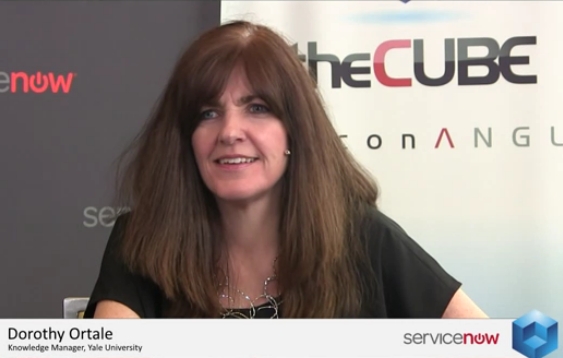 NEWS
NEWS
 NEWS
NEWS
 NEWS
NEWS
![]() TheCube host Dave Vellante was joined by guests Dorothy Ortale, Knowledge manager, Ricardo Chavira, IT Director, and Rick Smith, Director of Metrics & Quality Assurance with Yale University, to talk about the way practitioners are using ServiceNow at the recently concluded Knowledge13 conference.
TheCube host Dave Vellante was joined by guests Dorothy Ortale, Knowledge manager, Ricardo Chavira, IT Director, and Rick Smith, Director of Metrics & Quality Assurance with Yale University, to talk about the way practitioners are using ServiceNow at the recently concluded Knowledge13 conference.
Vellante admitted that he loves to come to these events, seeing what both the vendors and the customers are saying about the product. This time, the allignment is very high, and everyone seems to be on the same page.
Dorothy Ortale spoke with Velante about the Knowledge base, the creation process and the implementation of ServiceNow.
Obviously, knowledge is very important at Yale, but there are a lot of groups within the IT organization that have their own repository of knowledge — that what Yale is trying to do now, gathering all the knowledge into one database. The purpose of doing this is so the knowledge can be shared.
Ortale vouches they can provide rock-solid services for their clients whenever they call the help desk. They strive to increase the efficiency without rediscovering information. Knowledge management is fairly new and they are doing that using ServiceNow. The owners of the service are considered subject matter experts, and they are needed to write information regarding their subject, so the Tier 1 support can help the clients, having the most accurate information.
As for the process of knowledge creation, it’s a combination of capturing existing knowledge and proactively creating new ones. it is becoming a requirement now that, when a new service is being rolled out, knowledge must be present weeks before that, so that Tier 1 support can be educated. Tier 1 support is how clients perceive the company, so having good support is boosting clients’ confidence.
![]() About ending up using ServiceNow at Yale, Dorothy confessed she started out as a client, using Change Management and Incident Problem, and then, after being selected as Knowledge Manager, recommended it for use at work. To this day, it’s being used pretty much turnkey, with little customization.
About ending up using ServiceNow at Yale, Dorothy confessed she started out as a client, using Change Management and Incident Problem, and then, after being selected as Knowledge Manager, recommended it for use at work. To this day, it’s being used pretty much turnkey, with little customization.
What is interesting is that at Yale, ServiceNow is used as a publishing platform and a Content Management System, along with Drupal. Content is created within ServiceNow and then published on the web as How To articles.
Ortale emphasized that “knowledge is a process, not a tool. The tool is ServiceNow.”
Moving on to the IT Director, Ricardo Chavira, Vellante wanted to know how he sees the future of ServiceNow within the organization.
Ricardo Chavira is part of the Service Management team, primarily in charge with setting up and running service management program, which includes Incident Management, Change, Release, and Knowledge Management. It’s a combination of building and improving the processes, and working on governance issues in the entire organization.
Yale adopted ServiceNow as a service management platform (ITSM), and it does that very well, with a high degree of versatility. They’re currently developing a Configuration Management Data Base (CMDB), looking at Release manager, and al lot of other processes and the AppCreator.
Life before ServiceNow meant a lot of ad-hoc and inconsistent processes, resulting in a lot of finger pointing. What ServiceNow brought in was the accountability for the service owner from end-to-end, and it is definitely a platform that will be used in the future.
![]() For the final leg of the interview, Vellante turned to Rick Smith, Director of Metrics & Quality Assurance.
For the final leg of the interview, Vellante turned to Rick Smith, Director of Metrics & Quality Assurance.
Smith’s primarily responsibility is making sure Quality standards are met throughout the IT Systems and Services. He also ensures that they remain client-focused, and that they make fact-based decisions whenever possible.
“Pre-ServiceNow, Yale had a lot of data, but little information,” says Smith. “People were innundated with hundreds of thousands of reports. Those reports were not synthesized to give actionable information. Through the use of ServiceNow, it allowed us to categorize data, synthesize information from it and generate score cards in dashboards that were much more actionable,” clarified Smith. This way, managers were empowered to perform better and improve service to their clients.
Prioritizing data
As for measuring data, a lot of things can be measured, but those sets that are have to be the ones that return the most investment. The things that matter most to the clients are FACE: Fast, Accurate, Cost-efficient and Easy. If one provider manages to offer at least two or three metrics, their clients’ needs will be met.
Yale configured some standard reporting for the managers that made it easier to access the information they needed. ServiceNow, just like its name, provided immediate feedback. Once they knew how present performance was, they wanted to know how they were performing in the past, and tried to forecast their future performance. The triangulation of these three factors guides the managers in providing their services.
So, the key is to get the right metrics and to put them in the right people’s hands.
THANK YOU